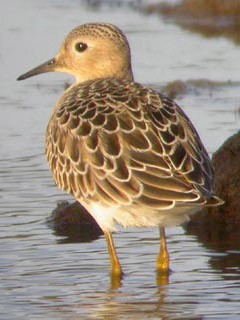 |
| Buff-breasted Sandpiper: Hickling Broad, Norfolk. Buff-breasted Sandpiper: a great bird to find but do you know the best ways to distinguish it from Ruff and decide whether it's an adult or a juvenile? (Photo: David Coxon) |
Waders rank amongst the most interesting of families for many birders. They're often relatively easy to find (and see), and they can, with perseverance and skill, be extremely confiding. Also, birders who like to find their own rarities often stand a good chance, even at inland locations. Additionally, the variation of plumages ensures that waders provide an identification challenge, both in terms of identification and ageing.
Personally, one of my favourite waders has long been the Buff-breasted Sandpiper. Since I saw my first I've been hooked by this charismatic wader. However, being a Yorkshire birder I've had relatively few opportunities to indulge myself in one of my favourite birds as the county boasts fewer than 20 previous records, involving perhaps a dozen birds. So, a 'Buff-breast' has been high on my list of 'want to finds', but away from southern Ireland and the southwest in autumn, you are really relying upon good fortune to secure your own 'self-found'.
Recently, an adult at Blacktoft Sands in East Yorkshire had whetted my appetite for seeing the species once again, but various commitments had prevented me from visiting the site during its stay (29th August-1st September). Aware that the bird had departed Blacktoft for pastures new I set about exploring my local patch in the Lower Derwent Valley near York in Yorkshire on my next full day in the field. The morning of 4th September had been a productive one spent in the field from dawn with my birding companion John Beaumont. I had been showing John around some locations in the valley, where recent floods had left the entire valley in a fabulous condition. We had spent the morning enjoying some superb local birding and decided to visit the little-known site at Thorganby Ings in the hope of adding to our increasing tally for the day.
As we reached the floodbank by the River Derwent at Thorganby it was clear that there were large numbers of waders at the site and we quickly located Little Stint and Curlew Sandpiper - both good local birds, plus numerous Ruff and commoner waders. As we scanned the marshy 'ings' a small wader appeared from behind the vegetation and one look at the distinctive walking action had both John and I calling almost simultaneously "Buff-breasted Sand" - for me I had achieved a goal of a 'self-found' Buff-breast, whilst for John it was nearly 17 years to the day since he had done the same thing on his own patch at a West Yorkshire reservoir.
The circumstances that had meshed together during that morning had ensured that the whole experience had been a total delight. The day had provided an excellent spell of birding, we were in a superb location on one of my 'patches' and the light was superb; furthermore the Buff-breast flew closer, allowing close views and the opportunity for some excellent digipics by John (typically, I had left my camera in the car!) 'Our' bird was an adult, just as the Blacktoft bird had been, and it seems probable that the same bird was involved. Just two years ago, Bank Island, just two miles to the north of Thorganby, had also accommodated an adult Buff-breasted Sandpiper - at the time I thought that was a one-off never to be repeated in an area that I have tramped for over 25 years. However, this recent bird illustrates that lightning does indeed strike twice - but this was presumably a different bird, as the adult in 2002 had been captured and ringed during a mist-netting session to capture Snipe.
 |
| Buff-breasted Sandpiper: Bank Island, N. Yorks. This adult female was captured during a Snipe ringing session in October 2002. |
British status
Buff-breasted Sandpiper is one of the commonest Nearctic waders to occur in Europe. In Britain the Buff-breasted Sandpiper is a scarce visitor, annual in occurrence, the majority in the autumn. Fraser and Rogers (2003) reported 612 birds between 1958 and 2001. Annual means per decade vary; from 21 per year between 1970 and 1979, there was a slight decrease to 19 birds per year in 1980-1999 and then 15 per year between 1990 and 1999. The highest annual total was 54 in 1977 and 48 in 1975, influxes that led to its removal from the list of species considered by the BBRC at the end of 1982. In keeping with other species deprived of their rarity status, this enigmatic wader became rarer thereafter! There would appear to be a slight upturn in recent years though, and the third highest ever annual total was noted in 1996 when 34 were found and there was an average of 22 birds between 2000 and 2001.
Distribution
Buff-breasted Sandpipers breed in Alaska and northwest Canada. In autumn the migration route takes it across central North America, but some cross the Great Lakes and head across the Atlantic on a great-circle route to their wintering grounds in northern Argentina, Paraguay and Uruguay.
Identification
Given reasonable views the identification of a Buff-breasted Sandpiper is a relatively straightforward process, the only potential pitfall being a small female Ruff. Many observers are often surprised at how small Buff-breasts are when they encounter their first. Another good feature for picking a Buff-breast out from other waders, and Ruff, is their habit of being constantly on the move, like a little clockwork mouse.
Habitat can sometimes be used as a pointer towards ID, as Buff-breasts tend to prefer drier habitat - they often tend to be detected on golf courses and airfields in the southwest for example. However, Ruff can also be found under such circumstances, and likewise, Buff-breasts can sometimes be found in wetter habitats.
When faced with a potential Buff-breast on the ground there are several features that can be quickly checked to eliminate a small juvenile Ruff:
- The mustard-yellow legs are relatively short compared with Ruff, with shorter tibia.
- There is a substantial projection of the primary tips beyond the tertials on Buff-breasts, unlike Ruff where the tertials tend to cloak the primary tips.
- On Buff-breasts the neck sides are clearly spotted; on Ruff these are plain.
- Unlike Ruff, Buff-breasts show an obvious pale eye-ring, apparent from quite some distance which accentuates the larger eye even more.
- The bill is short, blackish and straight on a Buff-breast; Ruff tend to show a pale base to a slightly decurved bill.
- Buff-breasts lack the darker eye-stripe of Ruff.
- The underparts are more subdued than juvenile Ruff, with a beautiful pinkish-buff suffusion on Buff-breast, lacking the darkness and obvious cut-off shown by Ruff.
- Ruff often show marked tertials and inner greater and median coverts, whereas on Buff-breasts this is lacking.
It is in flight that the differences between the two species become obviously apparent, with a view of a Buff-breast from above perhaps temporarily leading to confusion only with a Golden Plover. But it is in flight that Buff-breasts have a another captivating plumage feature to beguile their observer, as the silky-white underwing has two obvious dark crescents on the primary coverts - a feature apparent at quite some distance.
- In flight the upperparts lack an obvious wing-bar and they lack the white patches at the sides of the uppertail coverts of Ruff.
- On Ruff the feet clearly project beyond the tail, a feature not shown by Buff-breasts.
- The flight action of a Buff-breast is erratic, moving from side to side, unlike the direct languid flicking action of Ruff.
- Unlike other waders when they've been spooked, Buff-breasts prefer to crouch low to the ground, usually taking to the air some time after their congeners have flown.
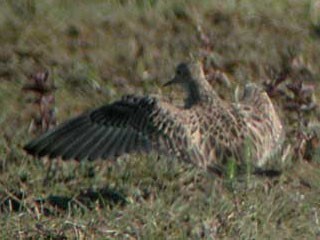 |
| Buff-breasted Sandpiper: Wicken Fen, Cambs. Note the lack of an obvious wing-bar and the concolourous uppertail coverts. (Photo: Dick Newell) |
Ageing
Ageing is relatively straightforward under good close views.
Adults tend be darker below than juveniles. The upperparts of adults in autumn are scaled buff, and are a mixture of old and new feathers. The coverts of adults have blackish central streaks and buff fringes, though these may be less obvious in autumn. The upperparts of adults are not as 'scaly looking' as juveniles. The undersides of the primaries exhibit bold blackish spotting. (Beaman and Madge 1998, Hayman et al. 1986, Lewington et al. 1991, Cramp et al. 1983).
 |
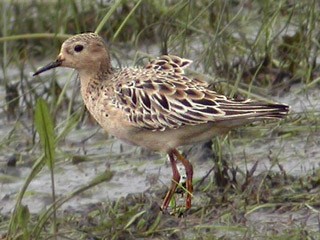 |
| Buff-breasted Sandpiper: Thorganby Ings, N. Yorks. Adults have blackish central streaks and buff fringes to the coverts. (Photo: John Beaumont) | Buff-breasted Sandpiper: Thorganby Ings, N. Yorks. Note the rusty fringes to the scapulars, mustard-yellow legs and short tibia. (Photo: John Beaumont) |
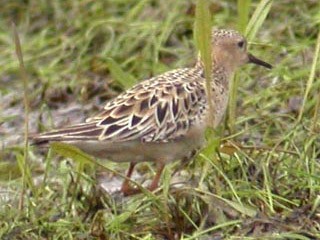 |
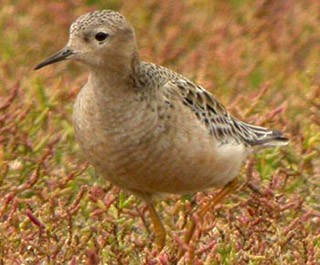 |
| Buff-breasted Sandpiper: Thorganby Ings, N. Yorks. The bill is short, blackish and straight. (Photo: John Beaumont) | Buff-breasted Sandpiper: Tacumshin, Co. Wexford. The pale eye-ring accentuates the large eye. (Photo: Paul and Andrea Kelly) |
 |
 |
| Buff-breasted Sandpiper: Tacumshin, Co. Wexford. Uniform pinkish-buff tone to underparts lacking clear cut-off, plus neat spots on breast sides. (Photo: Paul and Andrea Kelly) | Buff-breasted Sandpiper: Tacumshin, Co. Wexford. The primary tips clearly extend some way beyond the tertials. (Photo: Paul and Andrea Kelly) |
Juveniles are generally paler on the underparts compared to adults. Fresh upperparts appear 'scaly' with whitish-buff feather edgings. On the wing coverts they show dark centres with dark subterminal crescents. The undersides of the primaries are finely speckled dark brown in juveniles (Beaman and Madge 1998, Hayman et al.1986, Lewington et al. 1991, Cramp et al. 1983).
 |
| Buff-breasted Sandpiper: Hickling Broad, Norfolk. The wing coverts show dark centres with dark subterminal crescents and appear 'scaly' with whitish-buff feather edgings. (Photo: David Coxon) |
 |
 |
| Buff-breasted Sandpiper: St. Mary's, Scilly. Note the well-spotted breast sides. (Photo: Tristan Reid) | Buff-breasted Sandpiper: St. Mary's, Scilly. Buff-breasts are small birds, even next to a small wader such as a Dotterel! (Photo: Tristan Reid) |
 |
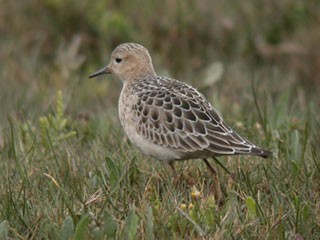 |
| Buff-breasted Sandpiper: Northwick Warth, Glos. The black eye and eye-ring are obvious in an otherwise plain face, as is the neatly streaked crown. (Photo: Paul Bowerman) | Buff-breasted Sandpiper: Northwick Warth, Glos. Plump and round-headed, giving a distinctive jizz. (Photo: Gary Thoburn) |
Ruff
The images below show the variability of Ruff.
 |
| Ruff: Martin Mere, Lancs. The wing bar is thin but obvious as are the white patches on the uppertail coverts. (Photo: Adrian Dancy) |
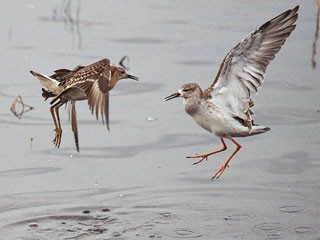 |
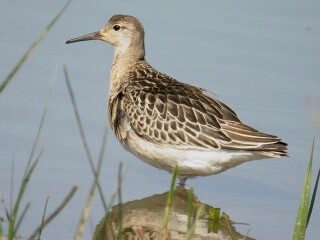 |
| Ruff: Martin Mere, Lancs. The dark crescent on the primary coverts is lacking compared to that of a Buff-breast. (Photo: Adrian Dancy) | Ruff: Blacktoft Sands, E. Yorks. There is very little projection of the primary tips beyond the tertials. (Photo: John Dickenson) |
 |
 |
| Ruff: Bank Island, N. Yorks. This bird looks superficially like a Buff-breast, but note the primary projection, plain breast sides, dark eye stripe, longer decurved bill and upperpart pattern. (Photo: Paul Hackett) | Ruff: Holywell Pond, Northumbs. The dark eye-stripe can be quite obvious. (Photo: John Malloy) |
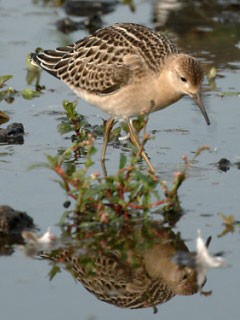 |
| Ruff: Pennington Flash, Gtr Manchester. The plain breast sides point straight to Ruff, as does the rich cinammon-buff colour of the underparts which ends quite abruptly. (Photo: Sue Tranter) |
References
Beaman, M and Madge, S. 1998. The handbook of bird identification for Europe and the Western Palearctic. London.
Lewington, I., Alström, P., and Colston, P. 1991. A field guide to the rare birds of Britian and Europe. Jersey.
Hayman, P., Marchant, J., and Prater, T. 1986. Shorebirds: an identification guide to the waders of the world. London.
Cramp, S., and Simmons, K. E. L. (eds.) 1983. The Birds of the Western Palearctic. Vol. 3. OUP. Oxford.


